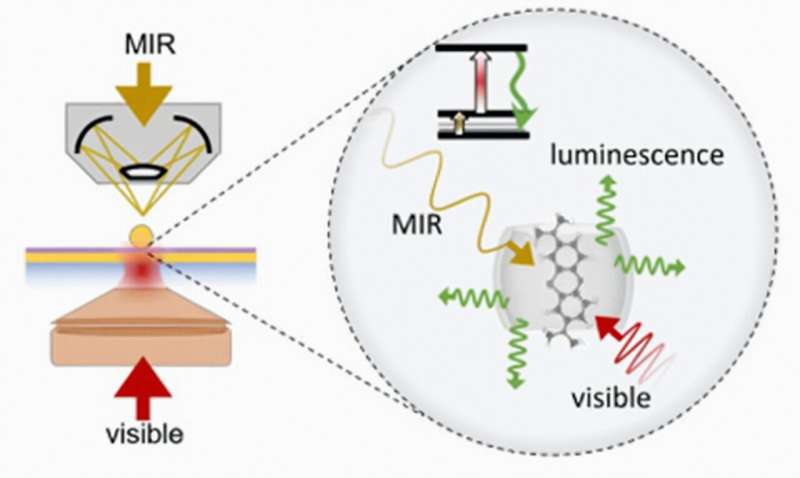This article has been reviewed according to Science X's editorial process and policies. Editors have highlighted the following attributes while ensuring the content's credibility:
fact-checked
peer-reviewed publication
trusted source
proofread
Making the invisible, visible: New method makes mid-infrared light detectable at room temperature

Scientists from the University of Birmingham and the University of Cambridge have developed a new method for detecting mid-infrared (MIR) light at room temperature using quantum systems.
The research, published in Nature Photonics, was conducted at the Cavendish Laboratory at the University of Cambridge and marks a significant breakthrough in the ability for scientists to gain insight into the working of chemical and biological molecules.
In the new method using quantum systems, the team converted low-energy MIR photons into high-energy visible photons using molecular emitters. The new innovation has the capability to help scientists detect MIR and perform spectroscopy at a single-molecule level, at room temperature.
Dr. Rohit Chikkaraddy, an Assistant Professor at the University of Birmingham, and lead author on the study explained, "The bonds that maintain the distance between atoms in molecules can vibrate like springs, and these vibrations resonate at very high frequencies. These springs can be excited by mid-infrared region light which is invisible to the human eye."
"At room temperature, these springs are in random motion which means that a major challenge in detecting mid-infrared light is avoiding this thermal noise. Modern detectors rely on cooled semiconductor devices that are energy-intensive and bulky, but our research presents a new and exicting way to detect this light at room temperature."
The new approach is called MIR Vibrationally-Assisted Luminescence (MIRVAL), and uses molecules that have the capability of being both MIR and visible light. The team were able to assemble the molecular emitters into a very small plasmonic cavity which was resonant in both the MIR and visible ranges. They further engineered it so that the molecular vibrational states and electronic states were able to interact, resulting in an efficient transduction of MIR light into enhanced visible luminescence.
Dr. Chikkaraddy continued, "The most challenging aspect was to bring together three widely different length scales—the visible wavelength which are hundreds of nanometers, molecular vibrations which are less than a nanometer, and the mid-infrared wavelengths which are ten thousand nanometers—into a single platform and combine them effectively."
Through the creation of picocavities, incredibly small cavities that trap light and are formed by single-atom defects on the metallic facets, the researchers were able to achieve extreme light confinement volume below one cubic nanometer. This meant the team could confine MIR light all the way down to the scale of a single molecule.
This breakthrough has the ability to deepen understanding of complex systems, and opens the gateway to infrared-active molecular vibrations, which are typically inaccessible at the single-molecule level. But MIRVAL could prove beneficial in a number of fields, beyond pure scientific research.
Dr. Chikkaraddy concluded, "MIRVAL could have a number of uses such as real-time gas sensing, medical diagnostics, astronomical surveys and quantum communication, as we can now see the vibrational fingerprint of individual molecules at MIR frequencies. The ability to detect MIR at room temperature means that it is that much easier to explore these applications and conduct further research in this field."
"Through further advancements, this novel method could not only find its way into practical devices that will shape the future of MIR technologies, but also unlock the ability to coherently manipulate the intricate interplay of 'balls with springs' atoms in molecular quantum systems."
More information: Single-molecule mid-infrared spectroscopy and detection through vibrationally assisted luminescence, Nature Photonics (2023). DOI: 10.1038/s41566-023-01263-4
Journal information: Nature Photonics
Provided by University of Birmingham





















